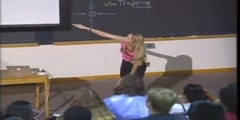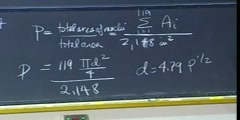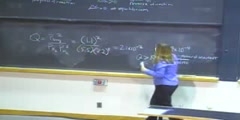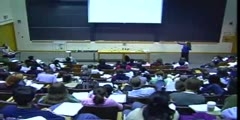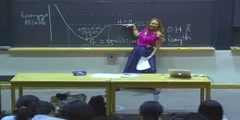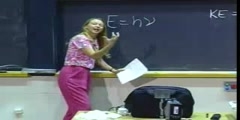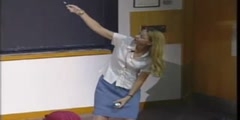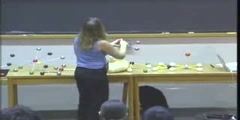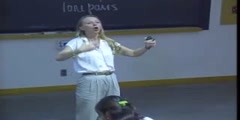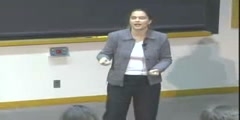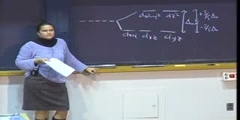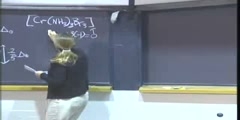Chemical Science-Atomic Theory of Matter lecture 1
Home > Courses > Chemistry > Principles of Chemical Science/n * Email this page/nVideo Lectures - Lecture 1/nTopics covered: /nAtomic Theory of Matter/nInstructor: /nProf. Sylvia Ceyer/nTranscript - Lecture 1/nAll right. What we are going to do today is I am going to start talking about the development of atomic theory. So, in the next few minutes, I am going to wiz through the observations that led to the belief that atoms were the most basic constituent of matter./nAnd then what we are going to see is that the atom can actually be split up, that the atom is not the most basic constituent of matter, that there is at least an electron and a nucleus. And we are going to start talking about what are the fundamental principles that have to obtain in order for that electron and nucleus to hang together to remain an entity./nAnd what we are going to see is that we are going to have to understand a new kind of mechanics to understand how that electron and nucleus hang together. And then further on in the course we are going to see we are going to need that new kind of mechanics to also understand how two atoms hang together, how two atoms bind to form a molecule./nAll right. But today I will lecture for the first two-thirds or three-quarters of the course and then I will stop. And then I will introduce the rest of our teaching team. And we will talk about the mechanics of the course./nWe will talk about the expectations of the course and some details like that. OK, so let's get going here. And now we could turn the lights down because I am going to use the slide here in the front./nAll right. The ancient Greek philosophers. They certainly were known to have pondered whether matter can be divided endlessly into smaller and smaller pieces or whether there was a point at which you couldn't divide matter any further./nAnd Aristotle here, well, he was one of the philosophers who argued that matter could be divided into smaller and smaller particles, chopped up into smaller and smaller pieces, add infinite, matter was divisible./nThis is called the Continuum Theory of Matter. Continuum because you don't have any discrete points. It is a continuum. No boundaries. But there was a contrary philosophy, a contrary philosophy heralded by Democritus who actually was about a hundred years older than Aristotle./nAnd he held that matter indeed was composed of individual discrete particles. These discrete particles he called ·tomos. A for not, tomos for divisible. That is the origin of our word, of course, atoms./nNow, in the 4th, 5th century BC, there wasn't much evidence one way or the other for either one of these philosophies. And I call it a philosophy because it was a search for understanding reality by a speculative as opposed to an investigational or observational means./nBut, for whatever reason, it was Aristotle here, his continuum theory of matter prevailed all the way to the 17th century. And here, in fact, he is depicted by Raphael on a fresco on the walls of the Vatican holding court, the continuum theory of matter./nBut, just about at the same time at which Raphael painted this picture, there were observations. A set of observations that were being made that began to point out that matter wasn't really behaving and reacting like a continuum, that matter was behaving more like it had some discrete nature to it./nWhat were those observations? Well, one of them was by this gentleman here, Robert Boyle. And guess what his formal occupation was? Chemistry? That's a good guess, but his formal occupation was a theologian, as most scientists were at that time./nAnd you, of course, know him for the empirical observation that the pressure times the volume is constant as long as the temperature is constant. But he actually advanced one of the first ideas of an element./nAnd that is he called an element a certain primitive unmingled body. And that somehow you can take these primitive unmingled bodies and put them together to form a perfectly mixed boy, a compound, a molecule./nSo, this was one of the first ideas of elements that come together to form molecules. And then there was this gentleman, Joseph Priestly. Guess what his occupation was? He was a priest, of course./nAnd what did he do? Well, he looked at reactions with deep logisticated air, deep logisticated air reacting with materials. And what he observed was that these materials reacted more vigorously in deep logisticated air./nWell, what is deep logisticated air? Well, of course, now we know deep logisticated air is oxygen. It is air with the nitrogen predominantly removed. But it really took this gentleman, Lavoisier, to really understand what Priestly was doing in his experiments./nAnd what Lavoisier realized is that this deep logistic air was kind of adding to the material when it did this reaction. And he made those observations, or he came to those conclusions by doing some very careful measurements of the mass before the reaction, so the mass of the deep logistic air plus the mass of the material./nAnd he found that indeed the mass after the reaction was equivalent to that before the reaction. And so he was one of the first individuals to realize that a chemical reaction can be written down analogous to writing an algebraic equation./nWell, Lavoisier also did a lot of work with isolating elements. He identified 17 metals and 9 nonmetals as elements. Well, for all of his efforts, we all know what happened to Lavoisier. Because of his connection to the French monarchy, the judge at his trial claimed that the republic has no use for savants./nLagrange at that time, a French mathematician said it took but a moment to cut through that head but it will require a hundred years to produce another like it. Well, there was another Frenchman at that time, J.L./nProust. He was a little more politically savvy. He high-tailed it over to Spain and led a long and healthful life as a professor in Madrid. But what he did was he did some experiments. And he observed that when two or more elements combine, well, they combine to form a compound, they always combine in definite proportions by weight and it didn't matter what the method of preparation was./nAnd, because he made this observation over and over again with many different elements, this became known as the Law of Definite Proportion. Again, some indication that matter had a discrete nature to it and it wasn't just the continuum./nSome numbers were involved here. But it really took this guy, John Dalton, English schoolteacher with a lot of interests. He was aware of the observations of Boyle and Priestly and Lavoisier and Proust./nAnd what he realized was that he could begin to understand all of those observations if he went back all the way to Democritus and Democritus' idea of ·tomos or atoms, these individual discrete particles of matter./nAnd so he set forth some postulates, some postulates which of course now are known as Dalton's Atomic Theory. But what he said was that each element is composed of atoms. He said that atoms of any given element are identical./nHe said that compounds form when atoms are more than one element combined. And he realized, of course from Lavoisier's observations, that atoms are neither created nor are they destroyed. Now, just an aside, John Dalton with his breadth of interest, he also was the first individual to document color blindness in human beings./nAnd, in fact, we do call color blindness Daltonism. See, we are getting you ready for medical school already. But what I want you to recognize here is that Mr. Dalton didn't actually do any of the experiments himself./nAlthough, from what I know of him, I think he could have done the experiments himself, but rather he was aware of the seemingly disparate observations made by Lavoisier and Boyle and Proust. And he just said well, you know, if I take those observations and I use this framework, well, then I can understand them./nThey make sense within this framework. And this is a powerful approach in science. A lot of science progresses this way. That is that there is this collection of seemingly disparate observations, and then all of a sudden somebody comes along and sees an organizing principle in all of those observations and puts forth them these postulates./nThat is what Dalton did here. Now, of course, these postulates weren't accepted immediately. And rightfully so because they were just postulates, they needed further substantiation. And that further substantiation came in terms of the work by this gentleman, Joseph Gay-Lussac, the Law of Combining Volumes./nIt came by the work of this gentleman. This gentleman is Lorenzo Romano Amadeo Carlo Avogadro's hypothesis. And, of course, you can all read Italian, so you can read what is on the stamp here, right? It just says equal volumes of gas under the same conditions of temperature lead to the same number of molecules./nSee, you didn't know you could read Italian but there it is. And further substantiation for this idea of an atom and the discreteness of matter came from this gentleman Ludwig Boltzmann. Gas Kinetic Theory./nHe proposed that well, you know, pressure, that must be due to these atoms that are moving around and hitting the walls of a vessel, those impacts give rise to the pressure that is exerted on the walls of that vessel./nAnd then, finally, it took this gentleman Cannizaro, and it took his statesmanship. Because what Cannizaro did, and now this is later 1800s or so. What Cannizaro did was that he got the scientific establishment at that time./nAnd the scientific establishment at that time, of course, was this small group of pale males. But he got them to listen to Dalton's Atomic Theory and then the ensuing experiments of Avogadro and Gay-Lussac, etc./nAnd, finally, he got them to say yes, there is something right about this Atomic Theory of Matter, the idea that mass was made up of discrete particles called ·tomos or atoms. Well, nowadays we, of course, can actually image individual atoms or molecules./nAnd what you see here is an array of 28 CO molecules. And these 28 CO molecules are arranged in the form of a little man or a little woman, I will let you figure it out, but these are CO molecules sitting on a platinum surface./nAnd so each one of these orange balls here is a CO molecule, but when CO binds to a platinum surface it does so with the carbon end down and the oxygen end up. And there is a really good reason for why that is the case, and we will talk about that when we talk about molecular orbitals./nWhat you are seeing here is really just the tops of the CO molecules. You are seeing the oxygen end of the CO molecule. All right. Well, this image here was taken by something called a scanning tunneling microscope./nAnd, I am sorry to say, but this was actually invented just before you were born. And it was invented, it was actually worked on by Binnig and Rohrer, and they won a Nobel Prize for their work. And the way the technique works is the following./nLet me have the board lights here. I am going to do some board work. What you do to do this is that you take a tungsten wire, and you do a little chemistry. You etch the tungsten wire down to as fine a tip as you can./nYou put it in some potassium hydroxide, you send some current through it, do a little electrochemistry, and what you will get then is a pretty fine tip at the end of this tungsten wire. But then what you do is you take that tungsten wire and you attach it to a piezoelectric crystal./nA piezoelectric crystal, and let me put it this way here, a piezoelectric material is some material that if you put a voltage across it, it expands a little bit, a little bit meaning 10, 20 angstroms./nAnd so now, if you attach the tungsten wire to that material, you have some control on the angstrom scale. So, that is what happens in order to move that tip around. But then what you do is you take this tip and you bring it, say, within 5 angstroms of the top of this CO molecule./nIf I have my platinum surface here and my carbon here and here is my oxygen, what I am going to do is I am going to bring this tip, say, within 5 angstroms here of this oxygen and of the CO molecule./nAnd then I am going to put a negative voltage on this tungsten tip here. And I am going to take the CO molecule, I am going to take the platinum surface and I am going to ground it. Now, in this tungsten tip there are, of course, electrons./nAnd, since this is a metal, metal has a characteristic where some of those electrons are not strongly bound to the nucleus. They actually roam around the solid. And this is a high energy state. Given that electrons are negatively charged and they are in an environment of this negative potential that is a rather high energy state for those electrons./nSo, if I were to draw an energy level diagram here, this is energy, and I am going to represent those electrons on the tungsten tip, it is going to be at a sum high energy level. This is electrons on the tungsten./nHowever, there are also some electrons down here and they are at ground potential. These electrons are at a lower energy, so I am going to draw an energy level representing them. This is the electrons on the platinum./nAnd so this coordinate here is kind of like a distance. So, this is the electrons on the tungsten, over here the electrons on the platinum. And what these electrons on the tungsten tip would like to do is to be here on the platinum because that is a lower energy state, but the problem is that there is a gap right here./nThere is no material between the tip and the oxygen end of the CO molecule. If you do it in a vacuum, there is a vacuum here, there is a vacuum gap. And so for the electrons to go from here to here, well, there is a very large barrier./nThis is a very high energy state if an electron were in between this gap here. I am going to represent that energy change as the electrons go from the tungsten tip to the platinum surface as a barrier like this, a very large barrier./nNow, you have seen these kinds of we call them reaction coordinates in chemistry in high school. That is you have seen situations where we might have, if we are doing an energy level diagram, this is the energy of the reactants out here./nThis is the energy of the products. And in between there is this activation energy barrier that we call Eact. In other words, you have to put energy into the system. In order to get the reaction to go, you have to put energy into the system before you get any energy back out./nAnd that is what happens in a chemical reaction, we put energy into the system before we make it go or can make it go. But in this particular case, the electrons, they don't behave like most reactants./nThe electrons right here, you know what they do? These electrons, they go right through that barrier. They don't care that there is a brick wall there. They just go right through the barrier. We call that tunneling./nAnd how in the world can that happen? Well, that can happen because electrons, unlike most atoms and molecules over here, are quantum mechanical particles. And they do not obey classical mechanical rules./nAnd that is a subject that we are going to start talking about today and tomorrow and for the next few days. These electrons, they just tunnel right through that barrier and get over here to the other side./nThat means, in this experimental setup, if I were to connect a wire from this tungsten tip here to the platinum, and I put in an ammeter right there, so I measure the current, I would be seeing some current flow, some measure of this flow of electrons from the tip to the tungsten./nAnd so that is what is done in the technique. But, now, how do you get this image that I showed you earlier from this kind of arrangement? Well, what you do is you now take this tungsten tip and you mount it on a piezoelectric crystal./nI forgot to tell you sometimes piezoelectric crystal, quartz is a piezoelectric, barium titanate is a piezoelectric. But you mount it on a piezoelectric crystal that will allow you to move from side to side./nI move now my tungsten tip over a little bit. And I know exactly how much over I moved it because I have calibrated by piezoelectric crystal. But now what do you see? Well, if you just moved it over, you didn't change the vertical distance, if you just moved it over, what do you think would happen to the current here? Decrease./nIt would absolutely decrease. Why? Because you now have changed the distance between the oxygen end and that tungsten tip. Over here, on this diagram, you made this barrier thicker. And the thicker you make it, the more difficult it is for those electrons to get through, so the current is going to go down./nIn order to bring the current back up, what you are going to do is you are going to take that tungsten tip and you are going to move it down slightly so that the distance now, between the tip and the oxygen, is going to be the same as it was in this particular position from here to here./nSo, then you bring the current back up. But, again, you know exactly how far down you moved that tip and how far over you moved that tip. You have got now two points. Now we have got to keep going./nWhat are we going to do to scan? Well, we're going to move this tungsten tip over again. And, again, the current in this particular case is going to go down. In order to bring it back up, you are going to move this tip further down so that the distance between here and here is the same as it was originally./nSo, reestablish the current. But, again, you know exactly how far down and how far over you moved the tip. And then what you do, you assign a different color to the different distances above the CO molecule./nAnd, if you assign different colors, you can get this image. For example, if we can dim the lights on the blackboard again, we will look at the slide. If the tip is very far from the surface, we would give it kind of a whitish color./nAnd as it gets closer and closer to the surface, we give it a darker and darker orangey color. And then finally, when it is so far down that it is actually in contact or tunneling to the platinum, we give it a blue color./nSo, that is how you get this image. That is the basis of this technique. Now you also notice that these CO molecules have a peculiar arrangement. And this is not due to, in the most au courant language, intelligent design./nRather this is due to a very patient experimentalist, i.e. graduate student, who spent 24 hours putting these CO molecules into this particular position. How did he do that? Well, he did it in the following way./nHe first took a few CO molecules and put them anywhere on the surface, just to expose the surface to some gas, and then he imaged the surface to figure out where they were. And so if these CO molecules -- My soccer balls are the CO molecules./nAnd if my foot here is the tungsten tip. You just imaged the surface to figure out where they were, because we knew where they were. Then he has got to move these CO molecules. He brings the tip close to one of the CO molecules./nAnd then, if you put a voltage pulse on that piezoelectric and actual jerk the tip, you can jerk it such that you hit the CO molecule and it goes flying away. That is nice, but now where did it go? Well, in order to find out you have to image the whole surface again./nAnd you would find that it is somewhere all the way over here. Now you really want it over there, so you repeat the operation. Well, 24 hours later you get this little man. [LAUGHTER] And I know it was 24 hours later./nIt is going to be a while before this kind of nanotechnology assembling a molecule by a molecule beats the synthesis in a beaker to put the molecules where you want them. But, even though this kind of visual observation of atoms and molecules really was impossible a hundred years ago, the evidence that I alluded to or quickly went through earlier was really quite compelling for the existence of atoms./nAnd the observation or the belief that the atom was the most basic constituent of matter, the elementary particle. You couldn't have anything smaller than an atom. And, in fact, at the end of the last century, it was generally believed that the theoretical structure of the universe was complete./nNature was understood. There were no more discoveries to be made. And, after all, there were, by this time in the last 1800s, a lot of advances. Well, Newtonian mechanics, that had already been known for 250 years, mechanics that guides the motion of all bodies around us, even astronomical bodies./nThermodynamics was completely developed. Statistical mechanics was developed, statistical mechanics which relates the microscopic description of the behavior of matter to the macroscopic description of the behavior of matter./nAnd also there were these optics experiments of Young, Freznel and Hertz that seemed to put to rest the question of whether or not light was a particle or a wave. Boy, those experiments seem to be absolutely conclusive that light was a wave./nThose experiments demonstrated Maxwell's equations, Maxwell's equations that unified the field of optics and electromagnetism. So, by this time there were all of these accomplishments. The idea was that everything was done, and the idea that was remaining, that the work that remained was largely to investigate the next decimal place./nEverything else was done. However, at the same time, by the late 1800s, there began to be two sets of observations, two tracks of observations that if you look closely began to illustrate that maybe things weren't quite so clear./nMaybe things were quite as well understood. And what were those observations? Well, one of those observations is the discovery, that we are going to start looking at today, that the atom is not the most basic constituent of matter, that you can take an atom apart into an electron and a nucleus, at least an electron and a nucleus./nSo, that is one track. The other track is that light appeared to behave in some cases like a particle and not a wave. And one of those cases is this observation here of the photoelectric effect. So, what we're going to do is look at both tracks of observations here./nAnd we are going to see how these observations made it such that it was impossible to explain how an atom held together, how an electron and a nucleus held together within the classical way of thinking, within the Newtonian mechanics, the mechanics that you are going to be looking at this semester in 8.01./nYou cannot use that mechanics to understand how this electron and the nucleus stay together. You cannot use that mechanics to understand how two atoms are bound together. We need a new way of thinking./nAnd it is these two tracks of observations that led to the discovery, in a sense, of this new kind of mechanics that we are going to be talking about. OK, so let's start on one of these tracks. And that track of seeing that the atom is not the most basic constituent to matter./nAnd the first observation was done by this gentleman, J.J. Thomas. It was the discovery of the electron. OK, so I am going to need the lights on again. All right. What J.J. Thomas was interested in doing was understanding what deep discharges were made of so he had a glass tube that was evacuated./nAnd in it he had what we're going to call here a cathode. And he had an anode. And, as I said, a glass tube pumps out the air and then he fills it up with hydrogen, H2. And what he does is he puts a large negative potential on this cathode./nAnd on the anode he puts a large positive potential, and he cranks up the potential difference here. And he keeps cranking it up until at some point the gas begins to glow. And it is at that point that this discharge here is ignited./nAnd this is kind of plasma. And he wanted to understand what is in this plasma. He was just curious. He wanted to know. And so what he does is he pokes a hole here in this anode. There's a hole./nAnd he lets out a little of this discharge. And he lets it out. And my chalk is breaking. He lets it out. And way back here he has some kind of a screen, a phosphor screen so that not only does this discharge here kind of glow as it's moving along, but when it hits the phosphor screen it lights up./nAnd so that's nice. But then what he does is he takes two parallel plates and puts them above and below this luminous beam, and there is a positive charge on one of these and a negative charge on the other./nAnd, low and behold, when he increases this potential difference, this delta V what happens is that this luminous beam, some of that luminous beam is actually deflected a little bit. And so now there is another very bright spot./nAnd he can measure this deflection. And we are going to call it delta X. Now, since some of this luminous beam was deflected toward a positively charged plate, what kind of particles did he decide were in this luminous beam? Negative particles because they're attracted to the positively charged plate./nSo, he called this deflection delta X. We will call it delta X sub minus. Now, he knew enough about electromagnetism at that time to realize that the amount of that deflection has to be directly proportional to how much charge was on the negatively charged particle./nAnd I am going to call that e sub minus. Because the more charge the easier it would be to deflect it. And he recognized that the amount of deflection has to be inversely proportional to the mass of that negatively charged particle./nBecause, after all, the more mass of that was the more difficult it was going to be to deflect it. And then what he did is he cranked up delta V as much as he could. And here I am taking a little liberty with the story./nI'm telling essentially the essence of the experiment, but it is a little more complicated than what it is I am going to tell you right here. But he cranked that up. And when he did, he realized that there actually were some other particles that were being deflected toward the negatively charged plate just a little bit./nAll right? Not a lot. Just a little bit. And, again, he could measure that deflection. And he called that, or we are going to call that delta X sub plus. These have got to be positively charged particles because they are attracted to the negatively charged plate./nAnd, again, he realized that delta X sub plus is proportional to a charge on that positively charged particle and inversely proportional to the mass of that positively charged particle. All right. But now here comes his thinking./nWhat he guessed is that these positively charged particles were H+, a hydrogen ion. How did he know that? Well, this was a guess. However, he did know that in this plasma, this discharge that there were hydrogen atoms./nAnd how he knew that is something we're going to talk about in a few days. But he knew that. He also knew H here, these hydrogen atoms that are produced in the plasma, somehow the plasma breaks the H2 bond, these hydrogen atoms were neutral./nAnd so he said, well, if it's a positively charged particle, well, gee, it must be that something was removed from the hydrogen atom to make it positively charged. And that something must be this negatively charged particle that I'm observing because I knew that originally the hydrogen atom has to be neutral./nSo, therefore, I am going to guess that the magnitude of the charge on the negatively charged particle is equal to the magnitude of the charge on that positively charged particle. And if that it is the case then I can take a ratio here of the deflection of the negatively charged particle to the deflection on the positively charged particle./nAnd, since these two are equal, I am guessing that, well, then this ratio has to just be equal to the mass of that positively charged hydrogen atom to the mass of that negatively charged particle. All right? And now here is the important point./nThe important point is that no matter how he made these measurements, no matter how he did that, the deflection for that negatively charged particle was much, much, much larger than the deflection for that positively charged particle./nThat then meant that the mass of this positively charged particle, which he guessed to be a hydrogen atom, must be much, much larger than the mass of the negatively charged particle. He also knew at that time that a hydrogen atom was the least massive atom, but here is an experiment that showed that there was a particle that was less massive than a hydrogen atom./nHey. But up until then it was the atom is the most basic constituent of matter. You cannot chop it up anymore. But here was the evidence that there was a particle less massive than the hydrogen atom./nEventually it is called an electron. But this is the first evidence here that the atom wasn't the most basic constituent of matter. Now, it actually took another ten years with the Millikan oil drop experiment to actually measure this ratio correctly and to determine the mass of the electron./nWe won't go into that. But this ratio here, you probably all know, the mass of the electron is about 836 times that of the mass of the hydrogen atom or hydrogen ion.
Channels: Chemistry (General)
Tags: chemical science atomic theary
Uploaded by: mitlectures ( Send Message ) on 16-04-2009.
Duration: 41m 59s
